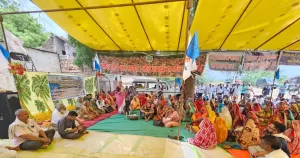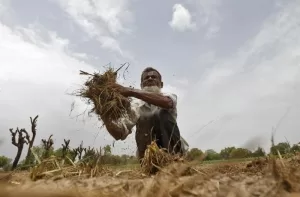Deepanshu Mohan, Jignesh Mistry, Vanshika Mittal, Rishiraj Sen and Mohd. Rameez
[Note: The Visual Storyboards team at the Centre for New Economics Studies, OP Jindal Global University in a recent field story spoke to the residents, farmers and activists of Vidarbha with a particular focus on three districts, Yavatmal, Amravati and Wardha, to understand how a multiple set of crises is afflicting the farming community there.]
The Vidarbha region of Maharashtra consists of eleven districts: Akola, Amravati, Washim, Nagpur, Yavatmal, Wardha, Buldhana, Chandrapur, Bhandara, Gadchiroli and Gondia.
As of 2012, 65% of the population living in this region was solely dependent on agriculture and allied activities for their livelihood and vocational needs. This is due to two reasons:
- the region has not received much industrial attention leading to underdevelopment of other alternative job opportunities – a fact true for most less developed agri-regions across India, and
- lack of good infrastructure for developing agri-business for those engaged in farming.
Being a largely agrarian economy, Vidarbha has over the years become notorious for reporting the highest number of cases of farmer suicides in the country. This region of 11 districts alone contributes to almost half of the cases from the entire state of Maharashtra.
The crisis has been well known and written about for decades now. Government intervention has happened but little has changed for farmers and their families on the ground.
Amongst the key issues affecting farmers, lack of uninterrupted access to water and electricity featured extensively in the voices of those interviewed. Farmers reported that in many areas, electricity is available only for a few hours a day. Other facilities such as roads and schools too are far-fetched resulting in a poorer standard of living for villagers.
“For farming, electricity is only provided for 12 hours. In a week, we have access to it during the day only for three days, the rest is supplied at night,” says Gopal, a male farmer from Wardha.
Unfortunately, agri-productivity in this region is below the national and state averages of productiveness. The water scarce belt receives 400-600 mm rainfall annually and relies heavily on cotton production. Insufficient water supply damages crop very easily making it a high-risk business for the farmers. Proper irrigation facilities are necessary for a fruitful yield. Sadly, of the eight districts that specialise in cultivating cotton, only 8-10% regions have proper irrigation connections.
“There is no water in our land… it is dry. It dries up really quick. If I pour water today, it only takes 2-3 days to dry up again,” says Mahananda Tombe, a woman farmer from Tembi (Ner).
“One of the major issues that Vidarbha has is the problem of irrigation. Majority of farming here is non-irrigational. If we see the data of last 4-5 years, we will find that the rate of suicide is more among farmers that don’t have irrigation facility,” says Harish Ethape, Coordinator for Vidarbha region at NAAM Foundation, Maharashtra.
Disproportionate impact
Women farmers bear the brunt in this agrarian crisis, creating an asymmetric division of pain and suffering for Vidarbha’s farming community and agri-class.
Traditionally, it has been observed that women farmers undertake more laborious and time-consuming processes such as weeding, loosening soil and seed preservation.
Despite the heavier workload, supporting households, and performing other intra-household ‘duties’, they are ‘invisibilised’ as workers in fields, usually owned by their male (farmer) counterparts restricting their access to agri-enabling systems such as markets, irrigation and storage infrastructure.
Furthermore, the daily wage for female workers is Rs 150, which is much lesser when compared to their male counterparts who earn Rs 350-400. The prevalence of gender inequality in law and its practice by the executive further deprives them of the right to possess land and move out of this oppressed cycle. As a result, women farmers are isolated and dependent on their husbands and fathers for the development of the fields and sale of the crops.
This shifts the burden of income generation on male farmers of the country who become debt ridden to maintain their farms in meagre monetary inflows. There are several reasons behind such inefficient agricultural yield which would be investigated deeper in the next section. This has come with an everyday rise in the number of farmers dying by suicide and a 3% rise in the numbers just between 2018 and 2019. The scale of this issue has managed to catch the attention of local policy makers that have promised ex- gratia or compensation packages after incidents of suicides, to the families of the farmers. However, this compensation does not come easily.
Widows are left at the mercy of their in-laws and rarely become beneficiaries of the land previously owned by their husbands.
Madhuri Khadse, a woman farmer and head of the Prerna Gram Vikas Sanstha recalls an instance where a widow was driven out by both her in-laws and brother along with her two sons. After she threatened to call the police, she was kept in a cow shed and given the bare minimum to survive on. Such events are common in villages as the woman is seen to have no value of her own.
Moreover, to avail themselves of ex-gratia, women go through a round of investigation that includes recounting the incident several times while proving and documenting the details of the suicide. Still, the compensation is meagre and cannot buy them more land.
A study found that widowed women farmers only became more vulnerable during and after the COVID-19 lockdown. The Maharashtra government issued a government resolution which stated that land rights along with 7/12, would be transferred to the widow, in case of farmer suicide, and it was hailed to be very progressive. But it failed in the implementation stage, and the widow women farmers continue to struggle.
Other factors that prevent high yields in Vidarbha are the micronutrient levels in the soil and repeated attacks from wild animals. “The animals cause a lot of damage. They destroy crops worth 1 lakh rupees annually,” claims Tushar who lost his father to suicide. Due to several challenges, farmers undertake the sowing cycle twice in order to make up for the lost crops. However, this only pushes them into debt as they borrow continuously. Government sources are too time consuming and complicated as they demand multiple documents and visits before providing the loan. On the other hand, quick money from private money lenders comes at soaring interest rates of 16 to 18%.
Additionally, market forces too do not work in the favour of these farmers. Since many lack the infrastructure to store their crops, the market has a heavy supply of crops as soon as the harvest is ready. This brings down the market prices depriving farmers from a decent income that they can use to repay their loans. In this manner, small scale farmers often fall into the debt- trap. Due to lack of natural resources, farming becomes difficult and due to lack of choice and proper infrastructure, changing professions seems like a utopian choice.
Farmers withstand absolute instability and an absence of security. 2019 was a difficult year for the harvest due to unseasonal rainfall, yet they failed to receive a loan waiver.
In the aftermath of the COVID-19 lockdown, in the fourth quarter of 2021, the Maha Vikas Agadhi announced a relief package to compensate the farmers whose crops were destroyed during the rainfall and floods. The second state loan waiver was also implemented in the state. However, all these combined too didn’t have much of an effect on the farmer suicides in the region. Amidst this, the need to empower women independently surfaces as a possible solution that would allow families to distribute the financial burden and provide women with agency.
Role of collectives and NGOs
An observation made in the Economic Survey of 2018 stated that the agricultural sector in India is undergoing feminisation due to outmigration of male members from rural villages to cities in search of better employment opportunities. In this context, it becomes even more important to equip women with the tools that will allow them to harvest to the best of their capabilities without gendered obstacles.
Harish Ethape, an agro-theatre activist from Vidarbha said:
“Relatively, women have an advantage over men in terms of financial and household management. They identify their household needs and prioritise it first. They keep aside some harvest for the household and efficiently reduce the costs. In fact, many separately sow more crops in small quantities for household consumption.”
Steps have been taken to mobilise women and empower them by pushing for collective farming. This helps combine small scale and marginal farmers, reduces the risks of taking loans and divides the burden of labour and operations. It has also formed a solidarity network where women motivate each other and break traditional stereotypes.
Madhuri Khadse speaks about the instance when many women in her village refused to cultivate turmeric due to its association with religious beliefs and how that would prevent them from entering the fields during their menstrual cycle. Madhuri took the initiative to grow turmeric and convinced everyone to do so too. “A flower bloomed in my fields in a few months. I took it around showing to everyone in order to inspire them in breaking the stereotype,” she said.
These collectives also play a very important role in rehabilitating widows that are tortured by their in-laws post the death of their husbands.
There has been a growing influence of agro-ecology leading to organic farming within such women collectives. Organic farming varies from region to region and previously, a resistance among marginalised groups would stem from the lack of understanding and guidance in accepting it. Now, collectives actively work in documenting the process and outcomes of different approaches. Moreover, they mitigate risk by already securing food for household consumption and working in groups. In this manner, these women are largely contributing to revitalising micronutrients in the soil and maintaining a seed bank at the very grassroots level.
Collectivisation and creation of semi-formal solidarity networks has allowed women farmers, even if in limited numbers across districts, to work together to improve their economic livelihoods and find better means for securing their (and their families’) lives.
Still, a lot needs to be done by local authorities and non-governmental organisations for those (mostly women) who are disproportionately affected by the lack of easier access to proper irrigation, fertilisers, cheaper agri-credit options, for sustaining higher yields in farming and ensuring a robust social safety net for the farming household. This will also help reduce the high incidence of farmer suicides in Vidarbha.
(Deepanshu Mohan is Associate Professor of Economics and Director, Centre for New Economics Studies (CNES), Jindal School of Liberal Arts and Humanities, O.P. Jindal Global University. Jignesh Mistry is a Photojournalist and a Senior Research Analyst and Visual Storyboard Team Lead with Centre for New Economics Studies, Jindal School of Liberal Arts and Humanities, O.P. Jindal Global University. Vanshika Mittal is Senior Research Analyst and Visual Storyboard Co-Team Lead with Centre for New Economics Studies, Jindal School of Liberal Arts and Humanities, O.P. Jindal Global University. Rishiraj Sen is Research Analyst with CNES and Mohd. Rameez is Senior Research Analyst with CNES. Courtesy: The Wire.)




